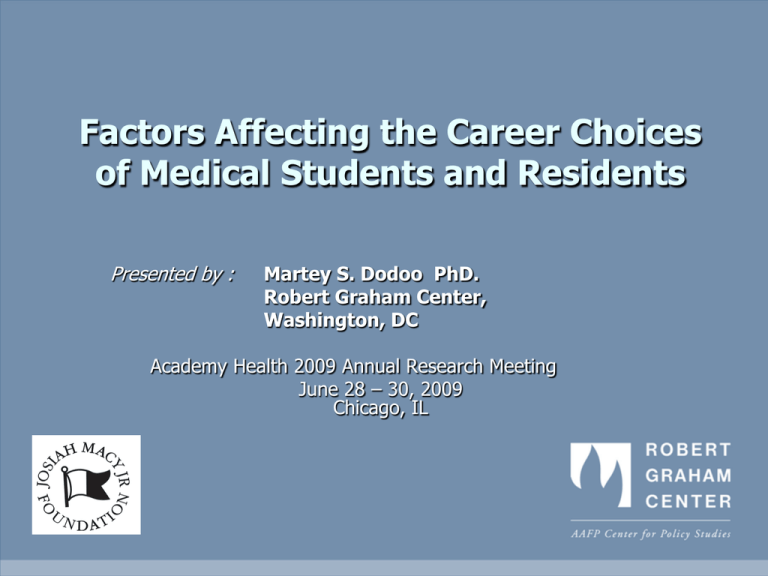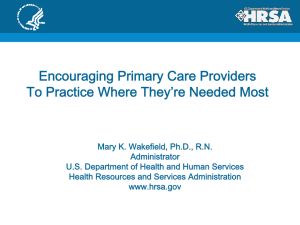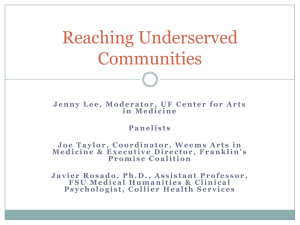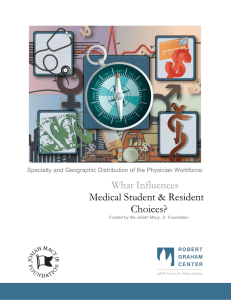Factors Affecting the Career Choices of Medical Students and Residents
advertisement

Factors Affecting the Career Choices of Medical Students and Residents Presented by : Martey S. Dodoo PhD. Robert Graham Center, Washington, DC Academy Health 2009 Annual Research Meeting June 28 – 30, 2009 Chicago, IL Background Policy: Physician training fewer primary care compared to sub-specialists Students: Declining popularity of primary care Payment models imbalance – PC vrs non-PC Imbalance increased costs & underserved areas So now more than ever, we need to understand: 1. Why students not choosing primary care or underserved practice 2. Where physician workforce can best be utilized to benefit greater society Previous Research Effect of: Student factors Debt (mixed) Loan repayment programs Institutional factors (3) Knowledge gaps & research question Major knowledge gaps in previous research: Debt & Interaction Scholarship & Loan repayment Student’s relative expected income Research Question: Do any of the following help predict specialty choice or practice location? Level of student debt? Exposure to Title VII funding? Student’s relative expected income? Returns to investment in medical education? Exposure to primary care or underserved training Data sources Graduation survey (GQ) (1979–2004) (AAMC) AMA Master file (2001 –05) Medicare outpatient claims -health centers (2001-05) NHSC participant database Title VII exposure data base (1979–2004) Primary care med. residency history data (1970-2004) Supplementary data Methods Quality checks of all data files Match/merged data files 1 analysis file For each set of variables: SAS (v9.2) calculations Logistic regressions Estimated average hours-adjusted NPV (ROI in medical education) Data merge/match diagram AAMC GQ AMA Master File Survey Debt Data (1998-2004) Physician Data (2001-2006) 310,705 710,988 Medicare claims in FQHC, RHC etc. (2001-2005) 174,310 visits 68,106 physicians 155,221 beneficiaries NHSC History & Title VII funding - NHSC service - NHSC scholarship obligation - Med School Title Funds Excluded - Ostepathic physicians - International Grads (IMG) - Graduated Med school before 1979 or after 2001 - Graduated residency before 1982 or after 2004 388,857 Analysis Data File 317,260 Residency History & Title VII funding Data VII 542,939 Geographic Data - RUCA codes Basic Findings Physician Distribution in analysis file (n=317,260) NHSC obligation & service Practice location NHSC scholarship 1.7% Practice in MUP 3.4% NHSC loan payment oblig. 0.7% Practice in MUA 14.6% Ever NHSC service 2.3% Practice in Popln. HPSA 11.1% Practice in Geog. HPSA 3.1% Career choice Family Physicians 13.2% Rural practice 9.8% General Internists 13.3% FQHC practice 4.7% Gen. Pediatricians 7.6% RHC practice 5.8% Not primary care 65.9% Ever Primary care 35.3% More findings Title VII exposure associated with: FM & und. electives FM & underserved practice Inner City, Rural, Primary Care Clerkships & Electives Matter Rural birth 2.4 x rural practice 1.8 x Family medicine practice Public Med School 1.8 x FM & Rural practice Men half as likely to primary care practice Women half as likely to rural practice Married docs 50% more likely to Family Med. practice Effect of debt: More findings With no debt less likely to rural, primary care practice Up to $150K debt more likely rural, PC practice Over $150K debt Likelihood of practice (above) declines Doctors trading debt for service up to 7 X more likely to choose primary care & underserved area practice FQHC or RHC practice: Enhanced by obligating scholarship. Reduced by having debt. Title VII exposure associated with increased rural practice Enhanced by an obligating scholarship. More Findings Trends in payments to physician groups(1979-2003) $450,000 Diagnostic Radiology $400,000 $300,000 $250,000 $200,000 $150,000 $100,000 Primary Care $50,000 20 03 20 01 19 99 19 97 19 95 19 93 19 91 19 89 19 87 19 85 19 83 19 81 $0 19 79 Median Annual Income $350,000 More Findings Average hours-adjusted Net Present Value (NPV) (5%) and Prim. Care vrs. non-PC Difference in Lifetime earnings: Primary care NPV Not prim. Care NPV Difference in total lifetime earnings 1980-1989 $12.54 $36.58 $1,751,724 1990-1999 $23.43 $59.95 $2,845,379 2000-2004 $29.58 $78.45 $4,093,931 Sources: Analyses from the Robert Graham Center, using data from AAMC, JAMA, Bureau of Labor Statistics, MGMA Study Limitations We could not obtain data on: Family income, Parent professional status, Career interests We did not find data on Osteopaths Pediatricians bill Medicare infrequently (only disabled beneficiaries). Policy Implications To promote primary care & redistribute physician workforce to underserved areas may have to: Reauthorize and revitalize Title VII Shift training underserved area communities. Increase primary care payments (cut disparity w/ non_PC payments) Admit students more likely to choose primary care or practice in underserved areas. Provide more “debt for service” programs What’s needed: Future studies on what makes underserved areas attractive practice locations, especially for women Our Study Team Acknowledgements This study was supported by The Josiah Macy Jr. Foundation The authors also wish to thank: Association of American Medical Colleges (AAMC) Diane Rittenhouse (UCSF) Scott Shipman (Dartmouth) Ed Fryer (University of Arkansas) Sarah Brotherton (AMA) Candice Chen (GWU) Fitzhugh Mullan (GWU) David Goodman (Dartmouth) Contact email: mdodoo@aafp.org








